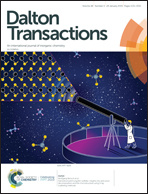A new family of dinuclear lanthanide complexes constructed from an 8-hydroxyquinoline Schiff base and β-diketone: magnetic properties and near-infrared luminescence†
Abstract
Six phenoxo–O bridged dinuclear lanthanide(III) complexes have been assembled utilizing the 2-[(4-nitrophenyl)imino]methyl-8-hydroxyquinoline (HL) and dibenzoylmethane (Hdbm) ligands: [Ln2(dbm)4L2] (Ln = Nd (1), Eu (2), Gd (3), Tb (4), Dy (5) and Er (6)). Complexes 1 and 6 exhibit the characteristic emission peaks of the corresponding Nd3+ and Er3+ ions, respectively. Meanwhile, the excitation wavelength (470 nm) for complex 1 is located in the visible-light region, confirming a practical application value. The studies on magnetic properties reveal that complex 3 features a magnetocaloric effect with a magnetic entropy change of −ΔSm = 14.36 J kg−1 K−1 at 4 K for ΔH = 7 T. What's more, the dynamic magnetic studies for complex 5 show that it exhibits slow magnetic relaxation behavior, typical of SMM behavior, resulting in an energy barrier of ΔE/kB = 75 K with the pre-exponential factor τ0 = 2.2 × 10−7 s. Meanwhile, this research demonstrates that the magnetic properties can be modulated by regulating the electron-donating/withdrawing effects of the substituents on the ligands.



 Please wait while we load your content...
Please wait while we load your content...